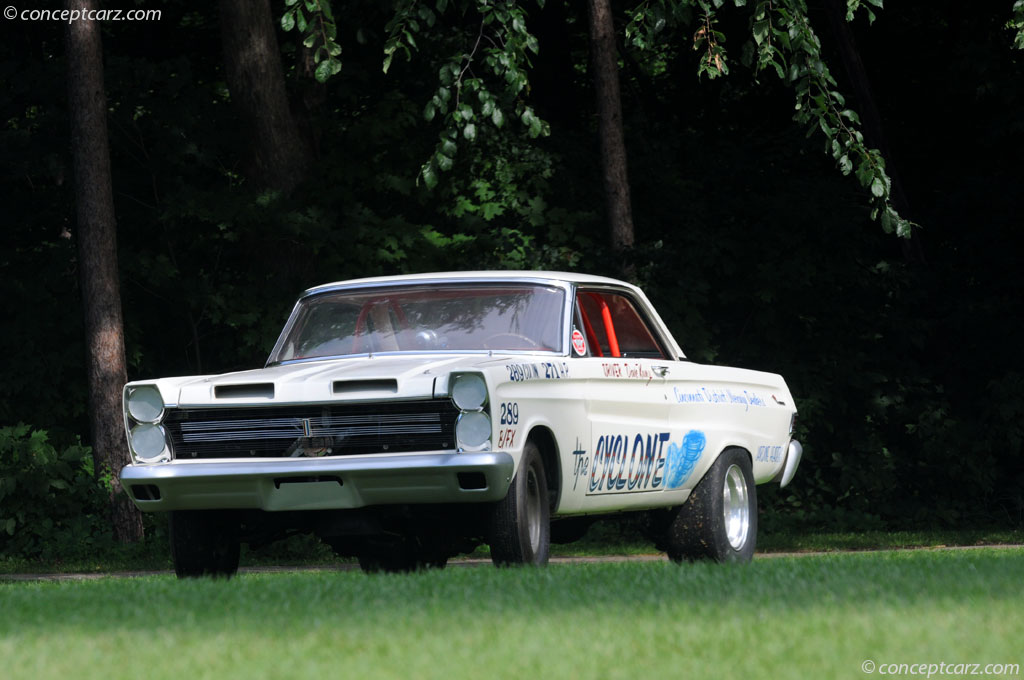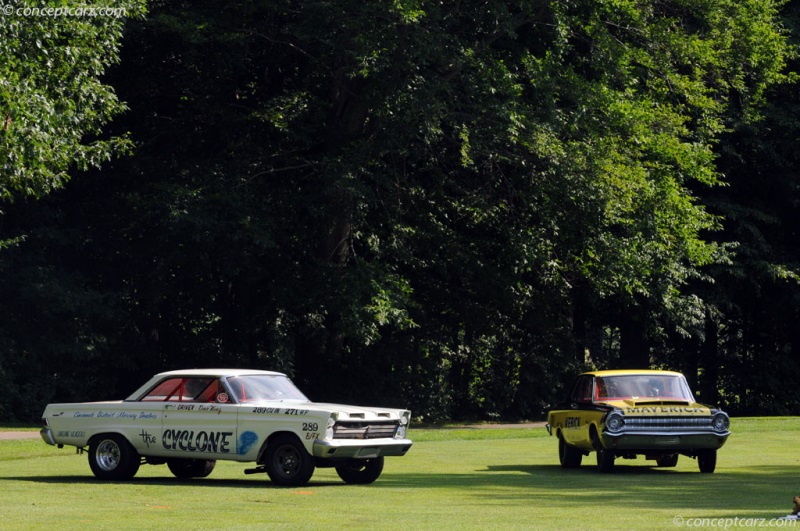1965 Mercury Comet Cyclone BFX Navigation



Coupe
From 1960 through 1967 Mercury, a division of the Ford Motor Company, produced the Comet. In 1970 there was no Comet but production resumed a year later and continued until 1977. The Comet was initially built atop a Ford Falcon frame that was stretched and became Mercury's intermediate/compact entry vehicle. With a 114 inch wheelbase, many thought it would be considered an intermediate, but Mercury classified it as a compact. In comparison to the Ford Falcon, the Mercury had more lavish and upgraded interior trim details. The Comet was intended to wear Edsel badging but when the brand was eliminated before the 1960 model year, Ford sold the Comet as a separate model through their Lincoln-Mercury dealers. The Comet continued to be its own model in 1961, the same year the S-22 model was introduced. The S-22 was two-door Comets with Moroccan vinyl bucket seats, stainless spoked steering wheel, and a center console. The carpet was upgraded, the wheel covers were stainless steel, and the rear quarter panels were given unique emblems. There were over 14,400 versions of the S-22 produced.In 1962 the Comet officially became apart of the Mercury line. There were little aesthetic changes in 1962 but as the years progressed, there was more ornamentation and trim adorned on the exterior.
The 1964 Comets grew in size and became more square. Mercury introduced three new packages but with the same body style and drivetrains. The packages were the Comet Caliente, Comet 202, and Comet 404. The Cyclone continued to be the sportiest of the package offerings. The Caliente was also a sports car option. The 202 version was an economical version while the 404 filled the gap between the offerings.The headlights became stacked and new finned taillights were added in 1965. A 289 cubic-inch V8 became available offering 225 horsepower. There were a few vehicles that came from the factory with a 289 V8 and over 270 horsepower, though this was technically not an option offered.In 1966 the Comet was all new. It now shared a body and chassis with the Ford Fairlane making it a true intermediate with its 116-inch wheelbase. A GT option was offered for an additional $452 which included a 390 cubic-inch V8 with a four-barrel carburetor, dual exhausts, fiberglass hood with non-functional scoops, and was capable of producing 335 horsepower. Power was sent to the rear wheels courtesy of a four-speed manual or automatic transmission. The front brakes were discs and a special handling package was offered to help with the extra power. The GT's were distinguished by their extra striping and badging.For 1967 sales began to drop considerably partly to due with the introduction of the Mercury Cougar. The name of the Comet was only used on the 202. This trend continued in 1968 and 1969 where the Comet name was used on the low-line models. There was no 1970 Comet but a year later the Comet re-appeared. It was available only as a coupe or a sedan.
By Daniel Vaughan | Jun 2006
A convertible option was offered on the Comet in 1963, with 13,111 owners opting for the option. The Comet Cyclone with its V8 engine was also offered in 1963. The 260 cubic-inch engine and four-speed floor shift transmission gave the Comet the power many buyers were hoping for.
By Daniel Vaughan | Jun 2006
In the beginning, the Comet was designed as an Edsel model and not officially a Mercury until 1962. The Comet was based on a stretched Ford Falcon from 1960 to 1964. Produced by the Mercury division of the Ford Motor Company between 1960 and 1977, the Comet was classified as a compact or intermediate-sized car. With a longer wheelbase and a better grade interior trim detail, the Comet was a much more updated version of the Falcon. The Comet had very distinct outer body panels.
After the release of the vehicle, the split grille was reformed into a model more in character with the Edsel models. Though the canted elliptical taillights were used and carried the 'E' (Edsel) part number on them though the lenses differed in length and width.
The Comet was eclipsed by the new Mercury Montego before being relegated to low-line models.By Jessica Donaldson
During the mid-1960's, Comets were available with Ford's highest performance muscle car engines of the day. About 50 models were produced, Comet Cyclones that were ultra-high performance lightweight vehicles that were equipped with a racing two carburetor 427 engine.
Developed at the same time as the Falcon, the Comet received a new grille design before its March 1960 introduction.
In design, the Comet was much like the Ford Falcon, except the Falcon came with a split grille.
Developed at the same time as the Falcon, the Comet received a new grille design before its March 1960 introduction.
In design, the Comet was much like the Ford Falcon, except the Falcon came with a split grille.
The Comet was eclipsed by the new Mercury Montego before being relegated to low-line models.By Jessica Donaldson
- 1965 Mercury Comet Cyclone BFX Menu
- Article
- Image gallery
- Valuation
- Specifications
- Profiles
- Production figures
1965 Mercury Comet Cyclone BFX Vehicle Profiles
Recent Vehicle Additions
Related Automotive News
NHRA SOUTHERNNATIONALS PREVIEW: MOPAR SALUTES DON SCHUMACHER, LOOKS TO DEFEND ATLANTA TITLE
- Mopar ready for the third event in three weeks, 33rd annual Summit Racing Equipment NHRA Southern Nationals in Atlanta
vMopar salutes Don Schumacher for his induction to the International Motorsports Hall of Fame
- Mopar is second in NHRA points standings...

FORD RACING HAS ENTHUSIAST NEEDS COVERED WITH A FULL LINEUP OF CRATE ENGINES AND PERFORMANCE PARTS FOR 2013
New 5.0-liter Aluminator V8 crate engine is now available to racers who want to build their own Mustang Cobra Jet
Restorers and modders can choose affordable V8 power ranging from the X302D to the 460-cubic-inch Z460, the biggest small-block ever...

TWO CHAMPIONSHIPS AND A WIN FOR MOPAR IN NHRA FINALS
Johnson Punctuates Championship with Seventh Win of the Season Beckman Claims Funny Car Crown with Mopar Power at NHRA Finals
Johnson caps his championship season with his first career win at the historic Pomona venue
Mopar-powered Dodge driver...

Limited-Edition Ford Racing History Artwork Unveiled at SEMA; Limited-Edition Print Sales to Benefit JDRF
Special limited-edition Ford Racing history artwork is unveiled at the annual SEMA show as part of the Ford press conference
Famed automotive artist Sam Bass created the artwork at the request of Edsel B. Ford II, with proceeds from sales of limit...
'GOING ROUNDS' THE GOAL FOR TEAM MOPAR DRIVER JOHNSON AS NHRA PRO STOCK TITLE FIGHT HITS VEGAS
Allen Johnson in position to claim back-to-back wins in Vegas in his Mopar Dodge Avenger
Dodge Charger RT Funny Car drivers Jack Beckman and Ron Capps continue championship battle in Las Vegas
Jeg Coughlin, Jr. primed to continue success at The...













